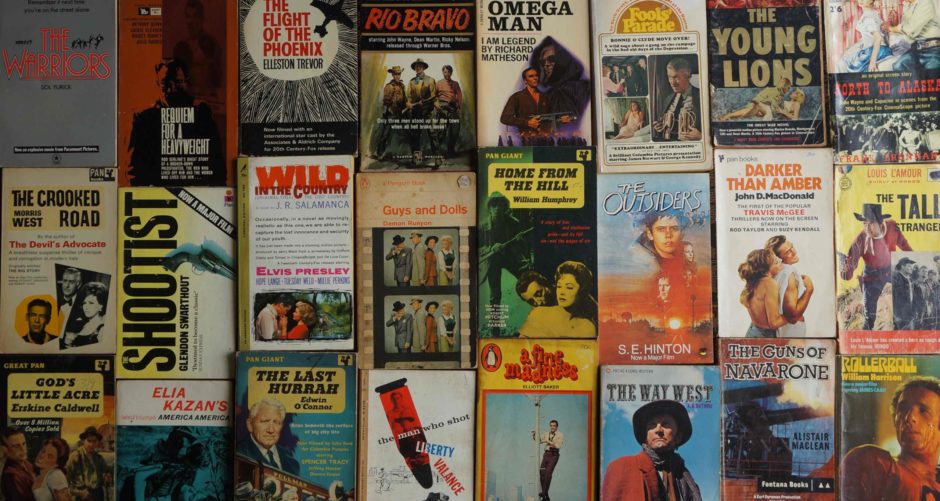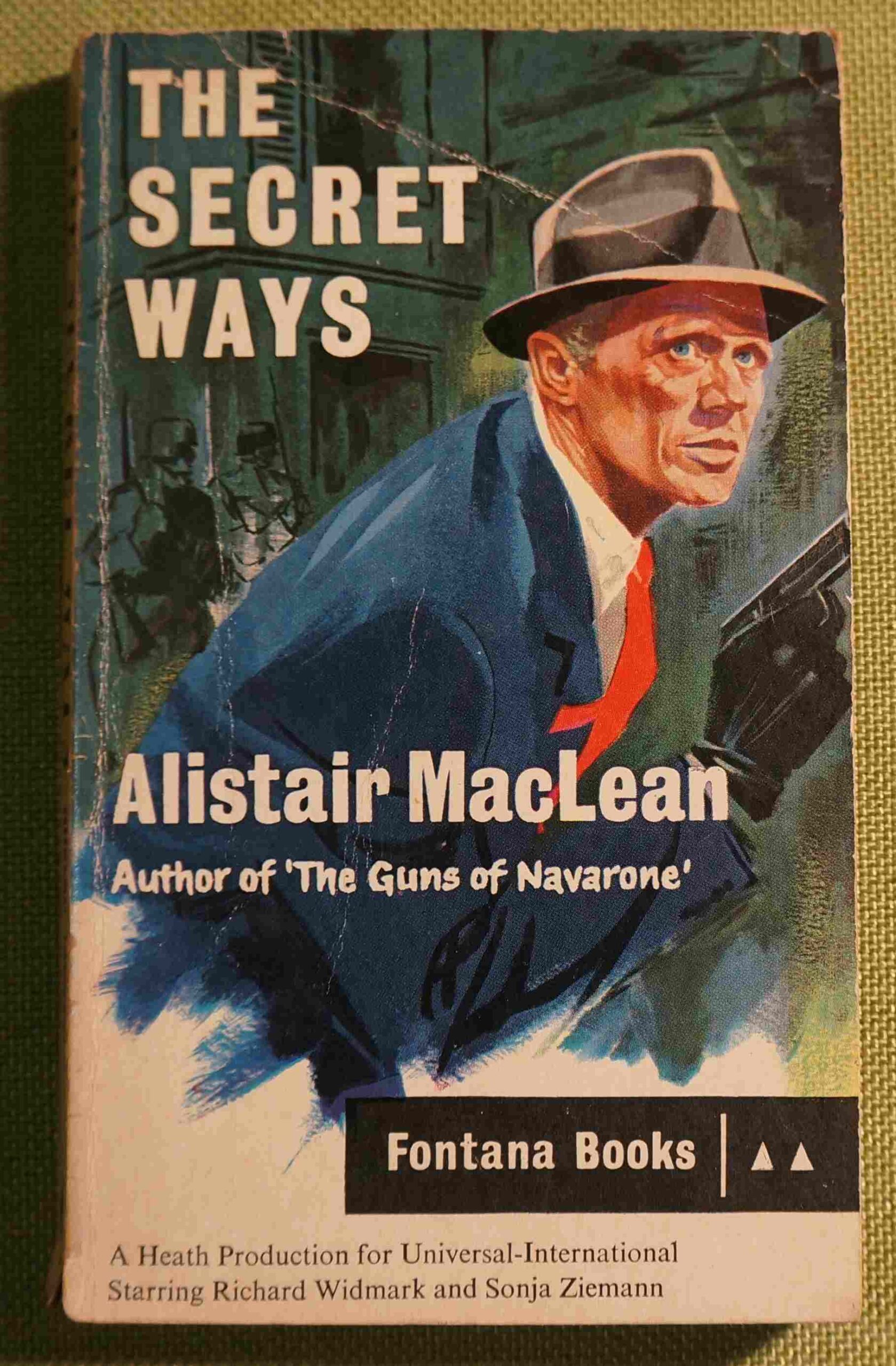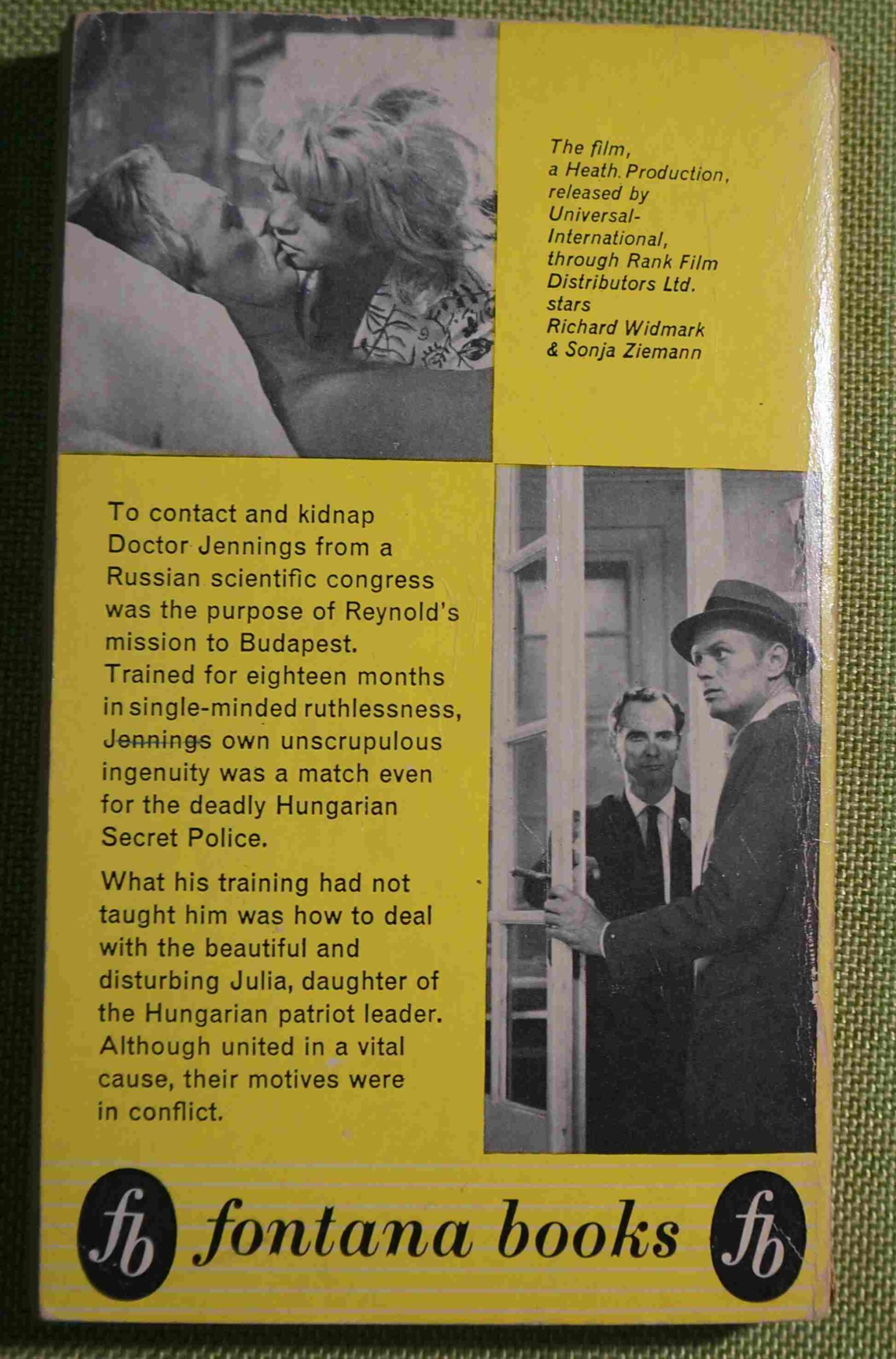FILM DIRECTOR: Phil Karlson
SCREENWRITER: Jean Hazlewood
FILM STARS: Richard Widmark, Sonja Ziemann, Charles Régnier, Walter Rilla, Senta Berger, Howard Vernon, Heinz Moog, Hubert von Meyerinck, Oskar Wegrostek, Stefan Schnabel, Elisabeth Neumann-Viertel, Helmut Janatsch.
COUNTRY: USA
THIS BOOK
AUTHOR: Alistair MacLean
TYPE: Novel
PUBLISHER: Fontana
THIS EDITION PUBLISHED: 1961
COUNTRY: Great Britain
COVER: Paperback
THE ORIGINAL BOOK
ORIGINAL AUTHOR: As Above
YEAR FIRST PUBLISHED: 1959
ORIGINAL BOOK TITLE: The Last Frontier
NOTES
GENRE: Action Thriller, Cold War
WORDS: I love cold war era skullduggery type films. I love their black and white outlook on the world. It is tempting to say that the world wasn’t black or white but I suspect now, with the passing of time, that one could say to look at the cold war as black or white is entirely appropriate.
The collapse of communism (replaced nowadays with fundamentalism and nationalism or a mix of both) in such a rapid fashion after the cracks appeared indicates everything. Dyed in the wool leftists (as I thought I was once) will have an excuse for everything … the West outmanoeuvred the Eastern Bloc, the USA used their economic might to compel the communists to gear money to arms rather than social welfare which caused the collapse of communism, the Communist states were not proper communist states). All this may be true but it is also clear the Eastern Bloc was a house of cards. From the first day only repression kept people in line. A buoyant economy may have kept them happy for a time (the buoyant economies were never buoyant for long) but they were only marginally happy as the buoyant economy came with repression, censorship and restrictions on religion and speech.
Once communism went, it went quickly. There were some who lived there and shed a tear, but not many. Only in the educated West did you get any support, sympathy or excuses made for the former communist regimes … regimes those people never lived under. In the former Eastern Bloc the stigma of communism remains, if it didn’t there would be no need for the parties of the far left to distance them from the old style communists and use “green”, or “socialist” or “liberal” in their names.
At the time though if it wasn’t so tragic it would be funny. The amount of people escaping (yes, “escaping” as there was no migration for 20 to 30 years after World War 2) from those countries by any means possible was akin to something out of a slapstick comedy.
All the Eastern Bloc nations were repressive, but they weren’t equally repressive. My parents, Croatians, escaped Yugoslavia which was relatively (perhaps) benign compared to Czechoslovakia (as it then was), East Germany, Hungary, Poland, Albania, Bulgaria, Romania and the puppet master that is the Soviet Union but that doesn’t mean you didn’t go to jail for looking sideways, it didn’t mean you could get ahead if you weren’t a member of “the party”, it didn’t mean there weren’t inequities and inequalities which were supported by law, it didn’t mean there wasn’t a new dominant class who preached brotherhood for all but failed to implement it. Everyone is equal but some are more equal than other … to paraphrase some author.
And that, perhaps, is yet another difference between the East and the West. The West was not without inequality, but they tried through law to address the same, and if that failed the people would point out why (though, perhaps, without much success). The East had similar laws though they were only tinsel. There was no desire to enforce them, and criticism and discussion was forbidden.
And there was no hiding it, internally or externally. No attempt even. There was no real attempt by communists to pretend that communist society was anything other than what it was.
It was easy then to paint the world in black and white, and Hollywood was very good at, and leant itself to such black and white storylines.
There were many interesting cold war films made, set in the US (The Manchurian Candidate (1962), Big Jim McLain (1952), The Fearmakers (1958), North By Northwest (1959), Pickup on South Street (1953)), or the Far East (Blood Alley (1955), Soldier of Fortune (1955), Hong Kong (1952)) as well as in Europe (The Third Man (1949), Torn Curtain (1966). Man on a Tightrope (1953), The Journey (1959), Diplomatic Courier (1952)).
MacLean’s book is black and white … there are good guys (from the West) and bad guys (the Communists). He isn’t into politics or history but gives enough background (perhaps a little more than normal in this book) to create an espionage thriller inspired by the events surrounding the Hungarian Revolution of 1956.
James Bond may be the height and most well known of the cold war spy characters but he is, in book and especially in film, a superman.
Here the protagonist, Michael Reynolds, is a British secret agent who doesn’t have gadgets or superskills. He is more real though not as “real” as the spies that would populate John le Carre novels later. Reynolds is sent on a wintertime mission to Hungary at the height of the Cold War to rescue an elderly British scientist who is held by the communist government against his will.
MacLean writes exciting adventures with enough of a foot on the road to stop his stories from taking off on fanciful flights, and importantly, he writes stories that are filmable.
His novel The Guns of Navarone (1957) was in film production, a big budget production as The Secret Ways (based on his novel The Last Frontier (1959) ) on a smaller budget was being filmed in Zurich and Vienna. The Secret Ways would be released first, becoming the first of the many Alistair MacLean film adaptations.
It’s a great little film … all black and white and of course adapted for American audiences.
Michael Reynolds here becomes a (more cynical and in it for the money) American adventurer hired by an international espionage ring to smuggle a noted scholar and resistance leader, Professor Jansci, out of Communist-ruled Hungary.
Star Richard Widmark, whose production company produced the film, was a bit of a liberal but he had no problems with the story which he called “an anti-Communist thing” which “had nothing to do with my [personal] politics.” https://en.wikipedia.org/wiki/The_Secret_Ways
Widmark’s wife, Jean Hazlewood, adapted the novel, her only screen credit. I suspect Widmark may have had a hand in the script but took no credit (he married his wife in 1942 and they were together until her death in 1997) because he was producing the film through his company.
The script is heavy on realism, well, realism surrounding the action. I suspect Widmark was looking for something in mood like his earlier cold war actioners Pickup on South Street (1953) and Hell and High Water (1954).
(The great) Phil Karlson was the perfect director for this or rather would have been five years earlier. Karlson was a master of injecting realism via brutal violence and unsentimental characters into films. He was on a roll in the 50s with masterpieces like Kansas City Confidential (1952), 99 River Street (1953), The Phenix City Story (1955), The Brothers Rico (1957) as well as superior entertainments Scandal Street (1952), They Rode West (1954), Tight Spot (1955), 5 Against the House (1955), Gunman’s Walk (1958), Hell to Eternity (1960). But, apparently, Karlson wanted something lighter – whether he is recalling this later as a result of hindsight in a post Bond world or not I don’t know – “Widmark hired him on the basis of The Phenix City Story because “he wanted to try to get realism in it” and the director told him “I wanted to do it as a James Bond. But he hadn’t heard of James Bond. I said, “If we do this tongue in cheek, we’ll be the first ones.” He said, “No, I don’t want to do it that way”.” Karlson says he left for the last week of filming (Widmark directed the last week uncredited). Years later, after Karlson made The Silencers (and the Wrecking Crew), a Bond-style spoof, he says Widmark tried to get him to do three more pictures. The director said, “He realized we’d have had, maybe, the first picture that would have taken him out of the role of the guy who kicks the old lady down the steps (referring to Widmark’s famous nasty tour de force in Kiss of Death (1947)).” https://en.wikipedia.org/wiki/The_Secret_Ways
Interestingly, apparently, Karlson was Albert R. Broccoli and Harry Saltzman’s first choice to direct their first James Bond film Dr. No (1962), but they were forced to decline him after he asked for too high of a salary.
Certainly, in the early 60s Karlson was moving away from the tight crime dramas and westerns he had made his name on and tackling romantic drama The Young Doctors (1961), musical drama – the excellent Elvis film (though not without its violence) Kid Galahad (1962), and an adventure film set in Malaysia, Rampage (1963).
In any event the decision to concentrate on realism is not a bad one. There is a lot of cold war atmosphere in this film and that is much of its attraction (filming in Europe helps also), and there was an appetite for such films even as Bond rose … The Spy Who Came in from the Cold (1965) was a success.
The cast is great. Widmark was never a conventional hero. He was always shifty, or rather, he was at his best when brutally pragmatic. The rest of the cast is populated by German and Austrian actors, which just adds to the cold war realism.
A much underrated film based on one of the best MacLean novels.
LINKS
TRAILER



It sounds like an interesting film, I will see if it is on YouTube.
Some of the most interesting spy films from the 1950s and 60s were film versions of novels. In addition to The Spy who came in from the Cold, you had Our Man in Havana and The Ipcress File. Both excellent films, in my opinion.
I think there was a novelisation of one the Derek Flint movies. If so , you should consider doing a blogpost about it. Our Man Flint is a very funny film ( the Austen Powers movies are really an homage to it) and peak 1960s.
I agree. I like the cold war spy films before they became to gadget driven (Bond) though the Flint movies (not sure if i have a novelisation) are, as you say, very funny, Coburn is perfect (Ray Danton who I love played him later in a TV film ….doesn’t work as well). The “Matt Helm” films are great for the same reasons as the Coburn Flint’s. Funny. They were jokey whilst Bond was still trying to be serious … it took till Moore to realise the silliness of the gadget superhero spy films. None of them could be made today, well, not without an outcry.